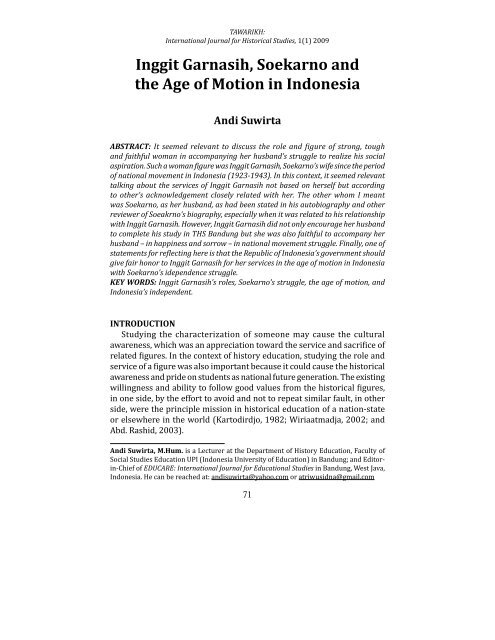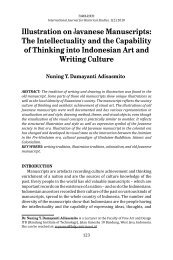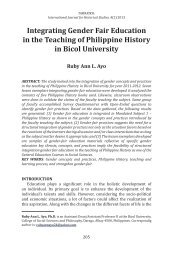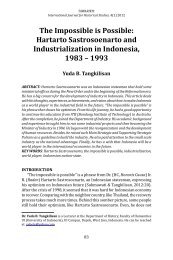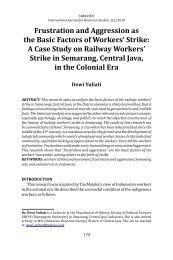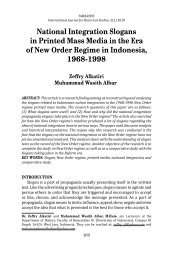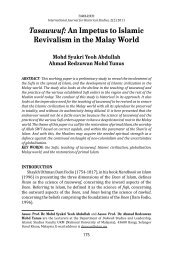The full article is as follows. - Tawarikh Journal
The full article is as follows. - Tawarikh Journal
The full article is as follows. - Tawarikh Journal
- No tags were found...
Create successful ePaper yourself
Turn your PDF publications into a flip-book with our unique Google optimized e-Paper software.
TAWARIKH:International <strong>Journal</strong> for H<strong>is</strong>torical Studies, 1(1) 2009adolescence w<strong>as</strong> p<strong>as</strong>sed through happily and cheer<strong>full</strong>y. After graduatingfrom religious education, equaled with Madr<strong>as</strong>ah Ibtidaiyah or IslamicElementary School (Hering, 2003:124), she grew up and moved to livewith her family in Bandung.Inggit Garn<strong>as</strong>ih must have experienced household life in relativelyyoung age. First, she w<strong>as</strong> married with Nataatmadja, an indigenous corporalwho worked in Karesidenan in Bandung (Ramadhan K.H., 1988:29). Th<strong>is</strong>marriage w<strong>as</strong> l<strong>as</strong>ted in 1910s when Inggit Garn<strong>as</strong>ih w<strong>as</strong> 20 years old.<strong>The</strong> first marriage did not l<strong>as</strong>t for long because it w<strong>as</strong> b<strong>as</strong>ed on jealousybetween both of them. Inggit Garn<strong>as</strong>ih, then, w<strong>as</strong> married with Haji Sanusi,a rich merchant who w<strong>as</strong> actively involved in Sarekat Islam organizationin Bandung. As wife and the member of SI (Sarekat Islam), Inggit Garn<strong>as</strong>ihhelped her husband’s effort to advance the organization in Bandung. WhenNATICO SI (National Conggress Sarekat Islam) held in Bandung in 1916,for example, Inggit Garn<strong>as</strong>ih involved herself <strong>as</strong> the head of ConsumptionCommittee to give accommodation service fot well-known SI figures such<strong>as</strong> H.O.S. (Haji Oemar Said) Cokroaminoto, Haji Agus Salim, and others(Ramadhan K.H., 1988:31).In 1923, Inggit Garn<strong>as</strong>ih w<strong>as</strong> divorced, but still in a good relationship,with Haji Sanusi, and then she w<strong>as</strong> married with Soekarno ali<strong>as</strong> Koesno,the student of THS (Techn<strong>is</strong>che Hoogeschool) in Bandung (Adams, 1965:80).<strong>The</strong> age of Inggit Garn<strong>as</strong>ih at that time – if h<strong>is</strong> birth year of 1888 w<strong>as</strong> true –w<strong>as</strong> 35 years old, while Soekarno w<strong>as</strong> just 22 years old. <strong>The</strong>y lived at JalanJaksa, Bandung, and <strong>as</strong> had been written by scholars studying Soekarno’sbiopgraphy, th<strong>is</strong> marriage w<strong>as</strong> l<strong>as</strong>ting for long and they were a harmoniouscouple (Legge, 1985:82).From 1923 to 1943, therefore, w<strong>as</strong> an important period for InggitGarn<strong>as</strong>ih’s life and struggle, and a focus of d<strong>is</strong>cussion in th<strong>is</strong> workingpaper. 1 At that time, Inggit Garn<strong>as</strong>ih did not only encourage her husbandto complete h<strong>is</strong> study in THS (ITB, Institut Teknologi Bandung or BandungInstitute of Technology, now), but she w<strong>as</strong> also faithful to accompany herhusband – in happiness and sorrow – in national movement struggle.When her husband w<strong>as</strong> caught, pun<strong>is</strong>hed and impr<strong>is</strong>oned (1929-1931) byDutch colonial in Bandung, then he w<strong>as</strong> thrown away to Flores in e<strong>as</strong>ternIndonesia (1932-1938) and Bengkulu in southern Sumatera (1938-1942),Inggit Garn<strong>as</strong>ih w<strong>as</strong> very faithful, tough and always accompanied himhappily.1Th<strong>is</strong> working paper w<strong>as</strong> presented and d<strong>is</strong>cussed in National Seminar on ProposingInggit Garn<strong>as</strong>ih <strong>as</strong> Indonesia National Hero in Bandung, West Java, Indonesia on December22, 2008.73
ANDI SUWIRTA,Inggit Garn<strong>as</strong>ih, Soekarno and the Age of Motion in Indonesia<strong>The</strong> explanation belom w<strong>as</strong> b<strong>as</strong>ed on the acknowledgment of Soekarnohimself in h<strong>is</strong> biography, <strong>as</strong> written by Cindy Adams (1965), besides b<strong>as</strong>edon the statements of some reviewers of Soekarno’s biography related toInggit Garn<strong>as</strong>ih’s life and struggle.A. Helping and Encouraging Her Husband to CompleteH<strong>is</strong> Study, 1921-1926As had been stated previously that Inggit Garn<strong>as</strong>ih w<strong>as</strong> married withSoekarno in 1923, when Soekarno w<strong>as</strong> studying in THS or ITB now.During Soekarno studied in THS, Inggit always encouraged, supportedand helped “Koesno” (her intimate calling for Soekarno) to fin<strong>is</strong>h h<strong>is</strong> study.Moreover, Soekarno w<strong>as</strong> confused and even hopeless to fin<strong>is</strong>h h<strong>is</strong> study– because H.O.S. Cokroaminoto w<strong>as</strong> impr<strong>is</strong>oned by Dutch colonial due toh<strong>is</strong> involvement in Afdeling B incidents of Sarekat Islam in Garut – InggitGarn<strong>as</strong>ih tried to convince Soekarno the importante of h<strong>is</strong> study to reachh<strong>is</strong> w<strong>is</strong>h in the future (Adams, 1965:74).Inggit Garn<strong>as</strong>ih knew exatly food drink Soekarno liked. “She prepared‘tubruk’ coffee, very dark coffee, that I could never m<strong>is</strong>sed”, Soekarno recalled(Adams, 1965:74), beside that he liked lodeh soup cooked by InggitGarn<strong>as</strong>ih. Recalling h<strong>is</strong> difficult and hard study times in THS Bandung,Soekarno pra<strong>is</strong>ed the goodness of Inggit Garn<strong>as</strong>ih who had played her role<strong>as</strong> a mother, lover and friend. <strong>The</strong> woman figure he yearned for w<strong>as</strong> InggitGarn<strong>as</strong>ih. <strong>The</strong>n Soekarno said <strong>as</strong> <strong>follows</strong>:[…] the happiness in new marriage would be reached if the wife had been acombination of a mother, lover and friend. I wanted to be cremated by my soulmate.When I got cold, I wanted to be m<strong>as</strong>saged by her. When I w<strong>as</strong> hungry, I wanted toeat the meals she cooked by herself. When my cloth w<strong>as</strong> torn, I wanted my wiferepaired it (Adams, 1965:76-77).<strong>The</strong> school fee of Soekarno in THS Bandung w<strong>as</strong> 300 Gulden a year. Hew<strong>as</strong> able to pay it, besides h<strong>is</strong> daily needs cost, not only being helped byh<strong>is</strong> parent and s<strong>is</strong>ter (Adams, 1965:75) but also being helped by h<strong>is</strong> wife.In such c<strong>as</strong>e, Inggit Garn<strong>as</strong>ih w<strong>as</strong> always ready to help and encourage herhusband to fin<strong>is</strong>h h<strong>is</strong> study <strong>as</strong> soon <strong>as</strong> possible, and also she w<strong>as</strong> alwaysdiligent and ready to work by selling jamu and face powder made by herselfand selling batik to earn for living with Soekarno (Hering, 2003:124-125).Soekarno, then, recalled the good services of Inggit Garn<strong>as</strong>ih economicallyin helping him by saying: “Inggit earned for living by selling face powderand cosmetic made by herself in our kitchen” (Adams, 1965:115).74
TAWARIKH:International <strong>Journal</strong> for H<strong>is</strong>torical Studies, 1(1) 2009By the encouragement and help from h<strong>is</strong> wife, Soekarno could p<strong>as</strong>s h<strong>is</strong>study well. Even when there w<strong>as</strong> no <strong>as</strong>signment – such <strong>as</strong> in holiday or atnight – Soekarno actively attended the political d<strong>is</strong>cussion, especially withthe figures of Ind<strong>is</strong>che Partij who were well-known in Bandung, such <strong>as</strong>Dr. Douwes Dekker (Setiabudhi), Dr. Tjipto Mangoenkoesoemo and M<strong>as</strong>Soewardi Soerjaningrat (Ki Hadjar Dewantara). H<strong>is</strong> intensive activitiessuch <strong>as</strong> reading books, having lecture, doing <strong>as</strong>signments and attendingpolitical d<strong>is</strong>cussion made him yearn for the ex<strong>is</strong>tence and the role of womanwho could understand and respect him. And Inggit Garn<strong>as</strong>ih, in Soekarnomemory, could play that role, by saying:Inggit who had round eyes and wore bracelet in her hand did not have brilliant p<strong>as</strong>ttime. She w<strong>as</strong> not educated at all, but her intelligence for me w<strong>as</strong> not important inthe self of woman. What I respected w<strong>as</strong> her humanity. Th<strong>is</strong> woman loved me much.She did not give opinions. She just looked at and waited for me, she encouragedand pra<strong>is</strong>ed me. She gave me all things that could not be given by books. She gaveme love, warmth and did not care about her. She gave everything I needed that Icould not be get since I left my mother’s (Adams, 1965:81).Soekarno graduated from THS in Bandung on May 25, 1926 (Adams,1965:91). H<strong>is</strong> future w<strong>as</strong> in front of him and there were a lot of choices:did he want to be Lecturer <strong>as</strong>s<strong>is</strong>tant in h<strong>is</strong> university, work in GeneralEmployement Department, or open private service agency in architecturefield? Soekarno ignored those chances and he preferred to choose politicalmovement world he w<strong>as</strong> interested in <strong>as</strong> the consequence of reading result,d<strong>is</strong>cussion and h<strong>is</strong> experience of life in Bandung. Soekarno w<strong>as</strong> very certainabout h<strong>is</strong> choice, moreover h<strong>is</strong> wife, Inggit Garn<strong>as</strong>ih, always encouragedand helped him. Soekarno recalled the critical times in h<strong>is</strong> life and relatedit to the ex<strong>is</strong>tence and role of Inggit Garn<strong>as</strong>ih, <strong>as</strong> following here:Inggit, in succeeding period in my life, w<strong>as</strong> very nice to me. She w<strong>as</strong> my inspiration.She w<strong>as</strong> my supporter. And I needed it all […] with Inggit beside me, I steppedforward to fulfill the trusteeship toward h<strong>is</strong> w<strong>is</strong>h (Adams, 1965:81).As the figure of movement who had “Ir.” degree, of course, Soekarno’shouse at Jalan Jaksa Bandung w<strong>as</strong> frequenlt v<strong>is</strong>ited by h<strong>is</strong> friends to d<strong>is</strong>cussand hold some political meeting. In such c<strong>as</strong>e, Inggit Garn<strong>as</strong>ih w<strong>as</strong> an open,warm and ready host. She welcomed the guests, l<strong>is</strong>tened to Soekarno andh<strong>is</strong> guests d<strong>is</strong>cussing and debating about movement political problems,and sometimes could calm down the hot debat situation that w<strong>as</strong> always75
ANDI SUWIRTA,Inggit Garn<strong>as</strong>ih, Soekarno and the Age of Motion in Indonesiadone sell, readily and appropriately by Inggit Garn<strong>as</strong>ih (Legge, 1985:119;Ramadhan KH, 1988:36; dan Hering, 2003:125).Soekarno w<strong>as</strong> very glad and respected such her attitude. Moreover,when Soekarno found the inspiration about the suitable ideology namefor the Partai National Indonesia (Indonesia National Party) in 1926/1927,which w<strong>as</strong> “Marhaen<strong>is</strong>me”, the attitude and response of Inggit Garn<strong>as</strong>ihw<strong>as</strong> <strong>as</strong> stated by Soekarno: “I talked, she l<strong>is</strong>tened to. I talked happily, sherespected” (Adams, 1965:78).B. Accompanying Her Husband in Happiness and Sorrowin Indonesia National Movement, 1929-1943<strong>The</strong> activity of Soekarno in political movement had been a problem forDutch colonial. H<strong>is</strong> attitude that did not want to comprom<strong>is</strong>e with Dutchcolonial always critized the Dutch political policies and <strong>as</strong>ked Indonesiancommunity to support the power and unity, made him <strong>as</strong> national movementfigure <strong>as</strong>sumed to be dangerous. <strong>The</strong>n, after Soekarno gave speech inSolo and went to Yogyakarta, in December 29, 1929, he w<strong>as</strong> impr<strong>is</strong>oned,then taken to Bandung and sent to “Rumah Pendjara Bantjeuy” (Adams,1965:125-126). For Soekarno, pr<strong>is</strong>on w<strong>as</strong> very irritating place, not onlyphysically but also psychologically and mindly. Public knew that Soekarnow<strong>as</strong> an individual who could not stand in facing quiet situation (Legge,1985:165; Dahm, 1987:218; and Hering, 2003:251-252), and in suchcondition the role of Inggit Garn<strong>as</strong>ih should be pra<strong>is</strong>ed due to her loyalty,toughness and tried to comfort and proed to her husband, Soekarno.On June 16, 1930, Soekarno had just been taken to the court. H<strong>is</strong> judicialprocess took long time and l<strong>as</strong>ted for months. After Soekarno deliveredspeech of h<strong>is</strong> famous plea, Indonesia Menggoegat, then on August 18, 1930– after eight months he w<strong>as</strong> in Bancuey pr<strong>is</strong>on – Soekarno w<strong>as</strong> sentenced bythe court at Jalan Landraad Bandung being pun<strong>is</strong>hed by 4-years in pr<strong>is</strong>onand sent to Sukam<strong>is</strong>kin pr<strong>is</strong>on in Bandung (Adams, 1965:136-142). <strong>The</strong>nagain, Soekarno w<strong>as</strong> thrown away to the quiet place that he hated muchand had irritated h<strong>is</strong> composure. 22About the story of Soekarno whou could not stand in facing quiet situation and<strong>is</strong>olation, it w<strong>as</strong> proved also 10 years later, which w<strong>as</strong> in 1948, when he w<strong>as</strong> <strong>is</strong>olated byDutch soldier to Br<strong>as</strong>tagi, Prapat, North Sumatera in which he fought with Soetan Sjahrir,the figure of movement who w<strong>as</strong> also allergic to the quiet situation. Moreover, 20 years later,in 1968 when Soekarno w<strong>as</strong> <strong>is</strong>olated by New Order government in W<strong>is</strong>ma Y<strong>as</strong>o, Jakarta,and w<strong>as</strong> not allowed to be seen by h<strong>is</strong> family and wives that made him truly hopeless andSoekarno p<strong>as</strong>sed away tragically and lonely in 1970.76
TAWARIKH:International <strong>Journal</strong> for H<strong>is</strong>torical Studies, 1(1) 2009Only Inggit Garn<strong>as</strong>ih and h<strong>is</strong> adopted child, Ratna Djoeami, could cheerhim up and made him stronger. <strong>The</strong> loyalty, composure, toughness andcheering attitude of Inggit toward her husband fate w<strong>as</strong> highly pra<strong>is</strong>edand recalled well by Soekarno (Adams, 1965:142-144). Moreover, Inggitin Soekarno’s eyes w<strong>as</strong> brilliant wife and could play the role <strong>as</strong> spy takingthe secret news of the events outside the pr<strong>is</strong>on. Soekarno rememberedthese events when Inggit Garn<strong>as</strong>ih v<strong>is</strong>ited and took him some foods for h<strong>is</strong>needs in Sukam<strong>is</strong>kin pr<strong>is</strong>on. Soekarno stated <strong>as</strong> <strong>follows</strong>:In c<strong>as</strong>e of bad news, Inggit sent him salt-egg. […] If my wife brought usual egg, Iwould examine first its crust before I ate it. One stab of pin meant “good news”.Two stabs “a friend w<strong>as</strong> caught”. Three stabs meant “m<strong>as</strong>sive attack, all leaderswere caught” (Adams, 1965:144-145).Soekarno w<strong>as</strong> rele<strong>as</strong>ed from Sukam<strong>is</strong>kin pr<strong>is</strong>on in Bandung onDecember 31, 1931, by Ducth colonial with h<strong>is</strong> hope that there w<strong>as</strong> achange in h<strong>is</strong> political movement and attitude (Adams, 1965:154). But eightmonths later (August, 1932), Soekarno w<strong>as</strong> re-caught by Dutch colonialbecause there w<strong>as</strong> no change in h<strong>is</strong> political attitude and himself (Adams,1965:166). <strong>The</strong>re w<strong>as</strong> no chance for him anymore. Without judicial process,he w<strong>as</strong> caught and given internir pun<strong>is</strong>hment to far and quiet place, whichw<strong>as</strong> Ende in Flores Island, Nusa Tenggara Timur.At th<strong>is</strong> time, the role of Garn<strong>as</strong>ih w<strong>as</strong> very vital. She w<strong>as</strong> faithsuland tough in accompanying her husband in p<strong>as</strong>sing through internirpun<strong>is</strong>hment that almost killed Soekarno’s life, inspiration and future (Dahm,1987:218-219). To cheer him up, Inggit also brought her widow mother(Mrs. Amsi) and her adopted child (Ratna Djuami). Sundanesse communitythen recalled the services of Soekarno’s wife in th<strong>is</strong> critical period by saying:“Indonesia w<strong>as</strong> independent due to the sacrifice of Sundanesse woman, whichw<strong>as</strong> madame Inggit Garn<strong>as</strong>ih. She defended her husband who w<strong>as</strong> thrownaway every where, greatly suffering” (Waluya, 2004).In such c<strong>as</strong>e, Soekarno also respected the role, services and glory ofh<strong>is</strong> wife, mother-in-law and adopted child (Adams, 1965:168). Moreover,Inggit’s attitude during accompanying her husband in Ende, Flores, w<strong>as</strong>pra<strong>is</strong>ed by Soekarno <strong>as</strong> stated following here:Inggit never moaned and complained. It w<strong>as</strong> her fate in th<strong>is</strong> life to give me thinkingcomposure and give me help lovely, not complicate my problems. But I also feltthat she w<strong>as</strong> suffering. […] it w<strong>as</strong> very irritating for a wife to see her husbandtaken away from h<strong>is</strong> living strength, from h<strong>is</strong> w<strong>is</strong>hes and h<strong>is</strong> happiness (Adams,1965:171).77
ANDI SUWIRTA,Inggit Garn<strong>as</strong>ih, Soekarno and the Age of Motion in Indonesia<strong>The</strong> year of 1935 w<strong>as</strong> a m<strong>is</strong>erable year for Inggit Garn<strong>as</strong>ih and Soekarnoin their exile place. On October 12, that year, Mrs. Amsi p<strong>as</strong>sed away inEnde due to arterio-scleros<strong>is</strong> d<strong>is</strong>e<strong>as</strong>e. Soekarno and Inggit Garn<strong>as</strong>ih shouldbury the body of their parent in the quiet exile place. <strong>The</strong>n, Soekarnoremembered the services and sacrifice of h<strong>is</strong> mother-in law by saying thatMrs Amsi w<strong>as</strong> illiterate woman, simpler that her daughter, Inggit Garn<strong>as</strong>ih,but she w<strong>as</strong> very honourable woman (Adams, 1965:172).M<strong>is</strong>erable days and gloomy future should be experienced by Soekarnodan Inggit Garn<strong>as</strong>ih in exile. Moreover, when Soekarno got malaria, InggitGarn<strong>as</strong>ih always cheered him up, took care and treated him faith<strong>full</strong>y,toughly and diligently. Although she w<strong>as</strong> suffering and sad, but in exileshe always encouraged Soekarno by giving prom<strong>is</strong>ing prediction in thefuture. Soekarno remembered and recalled what she had predicted, bysaying: “Inggit always convinced me that she felt on day I would be the onewho played the role” (Adams, 1965:182).Due to malaria d<strong>is</strong>e<strong>as</strong>e and pressure from national movement figureswho struggled cooperatively with Dutch colonial – especially, MohamadHoesni Thamrin – then, Soekarno on February 1938 w<strong>as</strong> moved to newexile, which w<strong>as</strong> Bengkulu in southern Sumatera (Adams, 1965:184-185).At th<strong>is</strong> time, Inggit Garn<strong>as</strong>ih w<strong>as</strong> still faithful and tough accompanyingher husband to Bengkulu. Although, it w<strong>as</strong> recorded that in Bengkulu, therelationship of Inggit and Soekarno worsened. <strong>The</strong> main cause w<strong>as</strong> thatInggit Garn<strong>as</strong>ih w<strong>as</strong> not able to give him baby after long time marriage.Other cause w<strong>as</strong> that Soekarno fell in love with other woman, Fatimah ali<strong>as</strong>Fatmawati, Bengkulu woman and the daughter of local Muhammadiyahorganization figure.But h<strong>is</strong> marriage life still maintained, at le<strong>as</strong>t until the Japan armyoccupied Indonesia dan defeated Dutch in 1942. <strong>The</strong> important note ofInggit Garn<strong>as</strong>ih in Japan occupation period w<strong>as</strong> her tough attitude indefending her husband when facing danger. Japan w<strong>as</strong> f<strong>as</strong>c<strong>is</strong>t and cruelgovernment toward those who made m<strong>is</strong>take, including Soekarno whoshould get strike on h<strong>is</strong> face (tempeleng) because he forgot to turn off thelamp at night. Soekarno remembered well that bad time and recalled howInggit Garn<strong>as</strong>ih defended her husband from the attack of Japan army, <strong>as</strong>following here:Seeing that incident, Inggit bended on her knees and shouted, “Ouw … ouw …don’t slap him. I will responsible. It <strong>is</strong> not h<strong>is</strong> fault. Oh, forgive him. I w<strong>as</strong> careless…!” (Adams, 1965:275).78
TAWARIKH:International <strong>Journal</strong> for H<strong>is</strong>torical Studies, 1(1) 2009Japan periode w<strong>as</strong> seen <strong>as</strong> force majeure by Soekarno and othernational movement figures, such <strong>as</strong> Mohamad Hatta. By that view, therew<strong>as</strong> no choice for Soekarno, except collaborating with Japan. Meanwhile,1943 w<strong>as</strong> an important year the life of Soekarno and Inggit Garn<strong>as</strong>ih. Atthat year, Soekarno did not only lead the PUTERA (Pusat Tenaga Rakyat)organization, but also he expressed h<strong>is</strong> willingness to marry with Fatmawatito have children. Although Soekarno had tried to explained logically andrationally h<strong>is</strong> willingness, 3 but the attitude of Inggit Garn<strong>as</strong>ih w<strong>as</strong> veryclear and strict, “Oh, being co-wife? If I must be co-wife, I never wanted!”(Galikano, 2006).THE END OF STORYIn 1943, Inggit Garn<strong>as</strong>ih divorced well with Soekarno and becamecommon people and lived at Jalan Ciateul (now Jalan Inggit Garn<strong>as</strong>ih) No.8in Bandung. <strong>The</strong> role of she had played for 20 years in accompanying herhusband w<strong>as</strong> described <strong>as</strong> “leading to the independence gate”. As statedin th<strong>is</strong> quotation:[…] in h<strong>is</strong> 40 years, Soekarno arrived in independence gate. Inggit Garn<strong>as</strong>ihtook him safely there. She w<strong>as</strong> not predestined to come to Istana Merdekawith Soekarno. Soekarno should start h<strong>is</strong> new life at that age (Poerad<strong>is</strong><strong>as</strong>tra,1988:ix).Entering the revolution period of Indonesia (1945-1950), InggitGarn<strong>as</strong>ih’s life in Bandung, <strong>as</strong> other common people, her house in Jalan3<strong>The</strong> attitude of Soekarno who always said the truth and gave logical and rationalre<strong>as</strong>ons if he wanted to marry another woman, would be recalled by h<strong>is</strong> wives <strong>as</strong> openand not hypocrite man (Ardhiati, 2005:118). Moreover, in c<strong>as</strong>e of approaching the divorcewith Inggit Garn<strong>as</strong>ih, Soekarno had <strong>as</strong>ked for opinions from Ratna Djoeami and h<strong>is</strong> lover,Asmara Hadi (coming from Bengkulu). Soekarno remembered the objection from h<strong>is</strong>adopted daughter and h<strong>is</strong> mother-in-law to be, in which they said: “What our people sayif you divorce Mrs. Inggit when she had been old and who had been faithful accompanyingyou during in pr<strong>is</strong>on and exile?” (Adams, 1965:197-198). But Soekarno w<strong>as</strong> still firm onh<strong>is</strong> stand that he wanted a baby, he wanted descent. See also other interesting <strong>article</strong> inthe newspaper of Utusan Malaysia, Monday edition, in 2001, with the title of “KehebatanSukarno Menakluk Hati Wanita”, in which the <strong>article</strong> concluded, in one side: “Sukarno w<strong>as</strong>not only remembered <strong>as</strong> prominent Indonesia leader who had devoted to Indonesia peoplefor almost 22 years, but he w<strong>as</strong> also known <strong>as</strong> the most excellent ‘woman conqueror’ in thecountry”. But in other side, the <strong>article</strong> gave also advices for men to behave well to women,by saying: “It w<strong>as</strong> <strong>as</strong> Soekarno said, ‘a wife will forgive and forget the bad attitude of herhusband, but her husband had affair with another woman [...] h<strong>is</strong> wife will never forget it’”[available at www.utusan.com.my, accessed in Bandung: 10 December 2008].79
ANDI SUWIRTA,Inggit Garn<strong>as</strong>ih, Soekarno and the Age of Motion in IndonesiaCiateul No.8 had been destroyed and flat with the ground when Bandungbecame fire sea on March 1946 (Galikano, 2006). Like other commonBandung people, Inggit Garn<strong>as</strong>ih followed to flee to southest Bandung,it might be going home to her hometown during childhood, which w<strong>as</strong>Kam<strong>as</strong>an village, Banjaran.After Indonesia w<strong>as</strong> independent, Inggit Garn<strong>as</strong>ih p<strong>as</strong>sed throughnormal life <strong>as</strong> usual. <strong>The</strong> work that always be done since a long time w<strong>as</strong>making jamu for beauty and other concoction that had cure ability (Legge,1985:82-83). Inggit Garn<strong>as</strong>ih went through her life normally, withoutany complaint and anger or even revenge to anyone, including to her exhusband,Soekarno ali<strong>as</strong> Koesno.One of the most prominent characters of Inggit Garn<strong>as</strong>ih w<strong>as</strong> herattitude to protect a good name and honor of her husband. Since hermarriage with Haji Sanusi (Inggit usually called him “Kang Uci”), shenever defamed her ex-husband. Moreover, when Soekarno, in 1960s, gavebad image of Haji Sanusi <strong>as</strong> “old people and never care about h<strong>is</strong> wife. Agambler with h<strong>is</strong> hobby to play billiard” (Adams, 1965:77), Inggit alwayshad good perception toward Kang Uci <strong>as</strong> rich merchant and Sarekat Islamorganization’s activ<strong>is</strong>t in Bandung.<strong>The</strong> similar thing prevailed, when the image and good name of Soekarnow<strong>as</strong> talked badly in 1980s related to amnesty letter to Dutch GeneralAttorney (Ingleson, 1983), then Inggit came forward by saying “It <strong>is</strong> taboo,it <strong>is</strong> impossible”, meant that such thing w<strong>as</strong> impossible and never be doneby Soekarno (Komp<strong>as</strong>, 7.10.1980).Inggit Garn<strong>as</strong>ih p<strong>as</strong>sed away in 1984 in her 96 years age. <strong>The</strong> simple,faithful and tough woman p<strong>as</strong>sing through her life w<strong>as</strong> still regarded <strong>as</strong> thewoman who had services in leading Soekarno to the independence gate.Sundanesse people generally stated two things about Inggit Garn<strong>as</strong>ih. Firstw<strong>as</strong> the statement in Sundanese language of “Moal aya Soekarno nu hebat,upama teu aya ibu Inggit” or there <strong>is</strong> no such great Soeakrno, if there <strong>is</strong> noMrs. Inggit”. It <strong>is</strong> meaning that inarguable acknowledgement about the roleof Inggit Garn<strong>as</strong>ih in Soekarno’s struggle to reach independence. Secondw<strong>as</strong> the statement also in Sundanese language of “B<strong>as</strong>a anjuenna pupus […]urang Bandung sanajan henteu aya nu miwarang, m<strong>as</strong>ang bandera satengahtiang sapanjang jalan nu kaliwatan ku layonna, kulantaran terang j<strong>as</strong>a-j<strong>as</strong>aanjuenna ke Republik ieu” or when she p<strong>as</strong>sed away [...] Bandung people,although they were not instructed, ra<strong>is</strong>ed half-pole flag along the streetthat w<strong>as</strong> p<strong>as</strong>sed through by her corpse, because they knew her servicesfor th<strong>is</strong> Republic (Waluya, 2004).80
TAWARIKH:International <strong>Journal</strong> for H<strong>is</strong>torical Studies, 1(1) 2009H<strong>is</strong>torian of UPI, Andi Suwirta (on the right), h<strong>as</strong> been explaining and presenting the paperin the National Seminar on the figure of Inggit Garn<strong>as</strong>ih to propose <strong>as</strong> Indonesian NationalHero in Aula Museum Sri Baduga, Jalan BKR, Kota Bandung, Monday (22/12/2008). InggitGanarsih h<strong>as</strong> participated and supported her husband, Ir. Soekarno (then become the firstPresident of the Republic of Indonesia), in gaining and preserving Indonesia’s independent.B<strong>as</strong>ed on her roles, she h<strong>as</strong> right to be recognized honorable <strong>as</strong> National Hero in Indonesia.Attending <strong>as</strong> other speakers are also H<strong>is</strong>tory Professor of UI (University of Indonesia),Susanto Zuhdi (in the centre), and Prof. Dr. Nina Herlina Lub<strong>is</strong> (on the left) <strong>as</strong> moderatorfrom UNPAD (Padjadjaran University).Finally, one of statements for reflecting here <strong>is</strong> that the Republic ofIndonesia’s government should give fair honor to Inggit Garn<strong>as</strong>ih for herservices in the age of motion in Indonesia with Soekarno’s idependencestruggle.ReferencesAbd. R<strong>as</strong>hid, Abd. Rahim. (2003). Pendidikan Sejarah: Falsafah, Teori dan Amalan. KualaLumpur: Utusan Publications.Abdullah, Taufik. (2002). Sejarah dan N<strong>as</strong>ional<strong>is</strong>me. Bandung: Satya H<strong>is</strong>torika.Ahmad, Q<strong>as</strong>im. (2004). Karya Sejarah: Pendekatan dan Persoalan. Kuala Lumpur: DewanBah<strong>as</strong>a dan Pustaka.81
ANDI SUWIRTA,Inggit Garn<strong>as</strong>ih, Soekarno and the Age of Motion in IndonesiaArdhiati, Yuke. (2005). Bung Karno, Sang Arsitek: Kajian Art<strong>is</strong>tik Karya Arsitektur, TataRuang Kota, Interior, Kria, SImbol, Mode Busana dan Teks Pidato, 1926-1965. Jakarta:Komunit<strong>as</strong> Bambu.Article “Inggit Garn<strong>as</strong>ih” in www.geogle.com [accessed in Bandung: 10 December 2008].Article “Kehebatan Sukarno Menakluk Hati Wanita” in the newspaper of Utusan Malaysia,Monday edition [2001]. Available also at: www.utusan.com.my [accessed in Bandung,West Java, Indonesia: 10 December 2008].Dahm, Berhnard. (1987). Sukarno dan Perjuangan Kemerdekaan. Translation. Jakarta:Penerbit LP3ES.Galikano, Silvia. (2006). “Nyar<strong>is</strong> Terlupakan” in Jurnal N<strong>as</strong>ional [October]; and availablealso at: www.geogle.com [accessed in Bandung: 10 December 2008].Hering, Bob. (2003). Soekarno, Bapak Indonesia Merdeka: Sebuah Biografi, 1901-1945.Translation. Jakarta: H<strong>as</strong>ta Mitra.Ingleson, John. (1983). Jalan ke Peng<strong>as</strong>ingan: Gerakan N<strong>as</strong>ional<strong>is</strong> Indonesia, 1927-1934.Transltaion. Jakarta: Penerbit LP3ES.Kartodirdjo, Sartono. (1982). Ke Arah Pemikiran H<strong>is</strong>toriografi Indonesia Sentr<strong>is</strong>: SebuahAlternatif. Jakarta: PT Gramedia.Legge, John D. (1985). Sukarno: Sebuah Biografi Politik. Translation. Jakarta: Penerbit SinarHarapan.Marching, Soe Tjen. (2008). “Just What <strong>is</strong> a ‘Hero’ Anyway?” in the newspaper of <strong>The</strong> JakartaPost. Jakarta: 4 th December.Mayong, Jacobus Kamarlo. (2005). “Menyedihkan, ‘Posko’ Pembentukan Negara RepublikIndonesia Terbengkalai” in www.geogle.com [accessed in Bandung: 10 December2008].Poerad<strong>is</strong><strong>as</strong>tra, S.I. (1988). “Sekapur Sirih” in Ramadhan K.H. Kuantar ke Gerbang: K<strong>is</strong>ah CintaIbu Inggit dengan Bung Karno. Jakarta: Pustaka Sinar Harapan, pp.vii-x.Ramadhan K.H. (1988). Kuantar ke Gerbang: K<strong>is</strong>ah Cinta Ibu Inggit dengan Bung Karno.Jakarta: Pustaka Sinar Harapan.<strong>The</strong> newspaper of Komp<strong>as</strong>. Jakarta: 7 October 1980.Waluya. (2004). “Aya Naon Jeung Urang Sunda?” in www.geogle.com [accessed in Bandung:15 December 2008].Wiriaatmadja, Rochiati. (2002). Pendidikan Sejarah di Indonesia: Perspektif Lokal, N<strong>as</strong>ionaldan Global. Bandung: H<strong>is</strong>toria Utama Press.82


